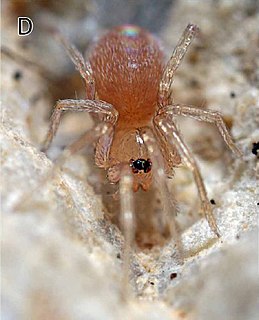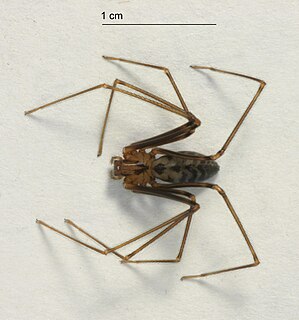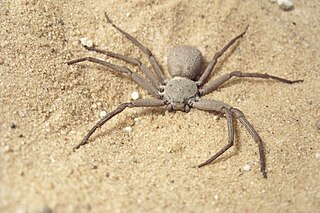
Anyphaenidae is a family of araneomorph spiders, sometimes called anyphaenid sac spiders. They are distinguished from the sac spiders of the family Clubionidae and other spiders by having the abdominal spiracle placed one third to one half of the way anterior to the spinnerets toward the epigastric furrow on the underside of the abdomen. In most spiders the spiracle is just anterior to the spinnerets. Like clubionids, anyphaenids have eight eyes arranged in two rows, conical anterior spinnerets and are wandering predators that build silken retreats, or sacs, usually on plant terminals, between leaves, under bark or under rocks. There are more than 500 species in over 50 genera worldwide.

Oonopidae, also known as goblin spiders, is a family of spiders consisting of over 1,600 described species in about 113 genera worldwide, with total species diversity estimated at 2000 to 2500 species. The type genus of the family is OonopsKeyserling, 1835.

Corinnidae is a family of araneomorph spiders, sometimes called corinnid sac spiders. The family, like other "clubionoid" families, has a confusing taxonomic history. Once it was a part of the large catch-all taxon Clubionidae, now very much smaller. The original members of the family are apparently similar only in that they have eight eyes arranged in two rows, conical anterior spinnerets that touch and are generally wandering predators that build silken retreats, or sacs, usually on plant terminals, between leaves, under bark or under rocks.
Misionella is a genus of South American crevice weavers that was first described by M. J. Ramírez & C. J. Grismado in 1997. In 2005 a spider fossil found in 15- to 20-million-year-old Miocene amber from the Dominican Republic was described as Misionella didicostae. A second specimen was discussed soon thereafter.

Drymusa is a genus of false violin spiders that was first described by Eugène Simon in 1892. They physically resemble violin spiders (Loxosceles), but their bites are not believed to be medically significant. Originally placed with the spitting spiders, it was moved to the Loxoscelidae in 1981, then to the Drymusidae in 1986.

Sicarius is a genus of recluse spiders that is potentially medically significant to humans. It is one of three genera in its family, all venomous spiders known for a bite that can induce loxoscelism. They live in deserts and arid regions of the Southern Hemisphere, and females use a mixture of sand and silk when producing egg sacs. The name is Latin for assassin.
Antônio Domingos Brescovit is a Brazilian arachnologist. His first name, Antônio may also be spelt António. He develops academic activities at the 'arthropodae laboratorium' at the Butantan Institute, and he is a specialist in Neotropical Arachnida.
Attacobius is a genus of South American corinnid sac spiders first described by Cândido Firmino de Mello-Leitão in 1925.
Otiothops is a genus of palp-footed spiders that was first described by W. S. MacLeay in 1839.
Tricongius is a genus of South American long-spinneret ground spiders that was first described by Eugène Louis Simon in 1893.

Strotarchus is a genus of araneomorph spiders in the family Cheiracanthiidae that was first described by Eugène Louis Simon in 1888. Originally added to the Clubionidae, it was moved to the Miturgidae in 1967, and to the Cheiracanthiidae in 2014. It is considered a senior synonym of Marcellina and Coreidon.
Macerio is a genus of araneomorph spiders in the family Cheiracanthiidae, first described by Eugène Simon in 1897.
Naevius is a genus of South American tangled nest spiders first described by V. D. Roth in 1967.

Baalzebub is a genus of ray spiders first described by Jonathan A. Coddington in 1986. Spiders in this genus typically live in dark environments, like caves.
Cinetomorpha is a genus of goblin spiders first described by Eugène Louis Simon in 1892. It is a senior synonym of Lucetia, and Yumates.






